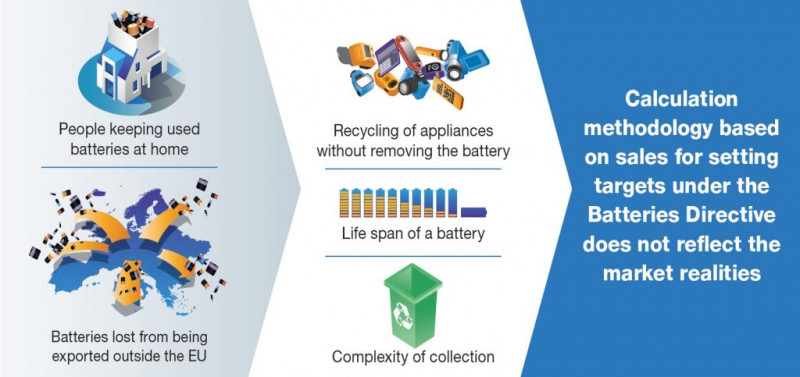Collection Targets
Published: January 30, 2024 | Last updated: January 31, 2024
EPBA has been advocating for targets based on the estimated number of batteries available for collection rather than the current three-year average sales basis. Currently, EPBA supports the European Commission's Joint Research Center (JRC) in developing an "Available for Collection" (AfC) methodology. This methodology is an alternative to the current approach, which sets collection rate targets based on the quantities of batteries that become waste.
Why not all waste batteries are being collected…
In the realm of battery collection, the current calculation methodology based on the number of batteries put on the market every year fails to acknowledge the reality of the battery market and the intricacies of collection. Recent evidence has demonstrated that setting higher collection targets based on the existing methodology does not necessarily translate into increased collection results.
It is important to dispel the misconception that a 45% collection target implies that the remaining 55% automatically ends up in household waste. In truth, a significant portion of these non-collected waste batteries simply are not available for collection. Instead, they may still be in use, as they tend to last much longer than the estimated three years. They may also have been hoarded by consumers or exported outside of Europe as part of electrical and electronic equipment (WEEE). According to data from EUCOBAT, less than 10% of portable batteries that enter the market ultimately end up as household waste.
Targets based on the Available for Collection calculation methodology
To address these challenges, JRC has explored an alternative approach called the "Available for Collection" (AfC) methodology. This methodology will establish collection rate targets based on the quantities of batteries that become available as waste. It will consider factors such as the lifespan of the batteries and the estimated percentage of waste batteries that are not returned to collection points, whether due to their inclusion in WEEE or their exportation with WEEE.
The Commission has until August 18, 2027, to formally adopt new methodologies. There will be different methodologies and collection rates for primary and rechargeable portable batteries, as well as separate rates for light means of transport (LMT) batteries. EPBA strongly supports the adoption of a new calculation methodology that accurately determines the volume of batteries available for collection. The development of a new AfC methodology is essential for maintaining and further enhancing the level of environmental ambition in collecting waste batteries.

Additional measures: Consumer awareness, fees, and kerbside collection
It is crucial to continue and gradually increase the collection target for portable waste batteries, as not disposing of them properly has a significant environmental impact and leads to material loss. To further improve collection rates, EPBA suggests implementing more educational campaigns aimed at consumers. Additionally, strategies such as kerbside collection and visible collection fees should be adopted to raise consumer awareness about battery collection and recycling and encourage their active participation in the process.
